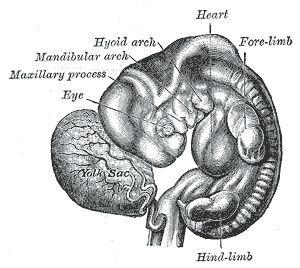Maxillary prominence
Maxillary prominence refers to one of the paired embryonic structures that contribute to the development of the middle and lower parts of the face, including the upper jaw (maxilla), cheeks, and part of the lip. This prominence is a critical component in the complex process of facial development during embryogenesis, which involves the growth, migration, and fusion of several distinct facial prominences.
Development[edit | edit source]
The maxillary prominences are derived from the first pharyngeal arch, one of the initial segments of tissue that appear in the early stages of embryonic development. Around the fourth week of human development, the first pharyngeal arch splits into two prominences on each side of the embryo: the mandibular prominence, which will form the lower jaw, and the maxillary prominence. The maxillary prominences grow and expand to form the majority of the upper lip, the cheeks, and the secondary palate, which is the posterior part of the roof of the mouth.
Role in Facial Formation[edit | edit source]
The maxillary prominence plays a crucial role in the formation of the face. It interacts with other facial prominences, such as the nasal prominences and the mandibular prominence, through a series of complex developmental processes, including growth, migration, and fusion. These interactions are essential for the proper formation of the face, and any disruptions in these processes can lead to congenital anomalies such as cleft lip and cleft palate.
Clinical Significance[edit | edit source]
Understanding the development of the maxillary prominence is important in the field of craniofacial surgery and pediatric medicine, as it can provide insights into the etiology of facial anomalies and guide surgical interventions. Conditions such as cleft lip and palate, which can affect feeding, speech, hearing, and dental development, are associated with disruptions in the normal development and fusion of the maxillary prominence with the nasal prominences and/or the mandibular prominence.
Research and Advances[edit | edit source]
Research in the area of maxillary prominence development focuses on understanding the genetic and environmental factors that influence facial development. Advances in genetics, molecular biology, and tissue engineering have provided new insights into the mechanisms underlying the development of the maxillary prominence and have opened up new avenues for the treatment and management of craniofacial anomalies.
Search WikiMD
Ad.Tired of being Overweight? Try W8MD's physician weight loss program.
Semaglutide (Ozempic / Wegovy and Tirzepatide (Mounjaro / Zepbound) available.
Advertise on WikiMD
|
WikiMD's Wellness Encyclopedia |
| Let Food Be Thy Medicine Medicine Thy Food - Hippocrates |
Translate this page: - East Asian
中文,
日本,
한국어,
South Asian
हिन्दी,
தமிழ்,
తెలుగు,
Urdu,
ಕನ್ನಡ,
Southeast Asian
Indonesian,
Vietnamese,
Thai,
မြန်မာဘာသာ,
বাংলা
European
español,
Deutsch,
français,
Greek,
português do Brasil,
polski,
română,
русский,
Nederlands,
norsk,
svenska,
suomi,
Italian
Middle Eastern & African
عربى,
Turkish,
Persian,
Hebrew,
Afrikaans,
isiZulu,
Kiswahili,
Other
Bulgarian,
Hungarian,
Czech,
Swedish,
മലയാളം,
मराठी,
ਪੰਜਾਬੀ,
ગુજરાતી,
Portuguese,
Ukrainian
Medical Disclaimer: WikiMD is not a substitute for professional medical advice. The information on WikiMD is provided as an information resource only, may be incorrect, outdated or misleading, and is not to be used or relied on for any diagnostic or treatment purposes. Please consult your health care provider before making any healthcare decisions or for guidance about a specific medical condition. WikiMD expressly disclaims responsibility, and shall have no liability, for any damages, loss, injury, or liability whatsoever suffered as a result of your reliance on the information contained in this site. By visiting this site you agree to the foregoing terms and conditions, which may from time to time be changed or supplemented by WikiMD. If you do not agree to the foregoing terms and conditions, you should not enter or use this site. See full disclaimer.
Credits:Most images are courtesy of Wikimedia commons, and templates, categories Wikipedia, licensed under CC BY SA or similar.
Contributors: Prab R. Tumpati, MD



